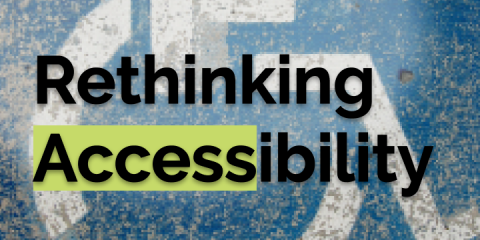Rethinking Accessibility

The thinking is changing around what “accessible” can mean and the role technology can play. Individuals, their families, providers, and case managers are all looking to technology supports to assist individuals (and the staff that help support them) reach their full potential.
The Story
Living Well Disability Services (Living Well) as an organization has used assistive technology in its support plans for over thirty years, beginning with low- and no-tech options. In the early nineties, eye gaze and other electronic technology was introduced to better support people with a range of needs and goals. Since beginning with technology solutions, Living Well has pushed forward and pursued the best support options available.
The Method
Though already “accessible” by the letter of the law, Living Well thought it could do better. And so it did, by rethinking accessibility as it relates to technology use for people of all abilities and by looking to examples in the community for inspiration and ideas. Living Well’s senior leadership continues to support assistive technology growth with organization-wide education, funding, and hours. Living Well began expanding its technology support options by investing heavily in innovative solutions—both on-site and at an infrastructural level. By coupling their therapy department with assistive technology specialists, Living Well was able to foster creative and dynamic care solutions on an individualized level. For example, Occupational Therapy and Assistive Technology staff look at a person’s abilities and the person’s skill level needed to complete a desired activity. To bridge the gap each staff member will find or modify tools to assist. When these tools increase, maintain, or improve someone’s functional capabilities, they meet the definition of assistive technology.
“I realized that so many commercial buildings have that accessibility for everybody, and why couldn't we have that at the home?...I mentioned that to somebody at our headquarters, and they helped me find the funding…” - Kit Piltingsrud, Program Manager, Living Well Disability Services
The Solution
Living Well’s efforts are made apparent through their work with Dan—a 65 year old man with cerebral palsy. Through conversations between Dan and staff, regarding his goals and needs, a plan was developed to give Dan the independence he desired—both in and outside of his home. To communicate (other than by vocalizing a simple ‘yes’ or ‘no’), Dan utilizes an Essence Language System communication device (acquired through waiver funding) as well as picture symbol communication for when his technology is unavailable or down. These assistive technology devices allow him to express his thoughts or feelings in greater detail. Learn more about Dan and how he utilizes assistive technology to communicate through art in the recent TRC article ‘Connecting through Technology’. Other assistive technology supports that have been added to his home include:
- Hands-free faucet
- Hands-free paper towel dispenser
- Automatic door openers for interior and exterior doors
- Drinking cup with built-in sturdy straw
- Radio control button sensor
For alone time in the community, Dan also utilizes a Tile tracking device to let staff know where to look for him if he is away longer than anticipated or if he leaves without first letting staff know.
The Results
By looking to technology commonly used in community settings for inspiration, Living Well staff was able to provide the support mix Dan had advocated for, giving him the independence he desired. Dan is enjoying the freedom his assistive technology provides, and continues discussions with staff around how he feels and what more he wants/needs to feel (in his words) like a person.
“When I hear the word accessibility, I think of having it available for everybody. Everybody, no matter what their ability level, making sure that every single living being can get in and out and be able to access whatever that is in whatever means that they can. It doesn't necessarily mean that they can do it like everybody else, but it bridges the gap so that we can all meet in the middle.” - Kit Piltingsrud, Program Manager, Living Well Disability Services
As part of its ongoing education on assistive technologies, Living Well continues to empower staff to search for additional technology supports through conferences and other professional development opportunities to assist the individuals they support live as independently as possible in their homes and in their communities. As with all technology implementations, continued conversations and discussions to evaluate and evolve the supports with the individual is critical to ensure the goals of the individual are met.
Don't miss the next article!
Visit the ARRM Technology Resource Center to learn about more success stories and case studies showing how technology is changing the lives of those living with disabilities or learn more about how to start the conversation.




